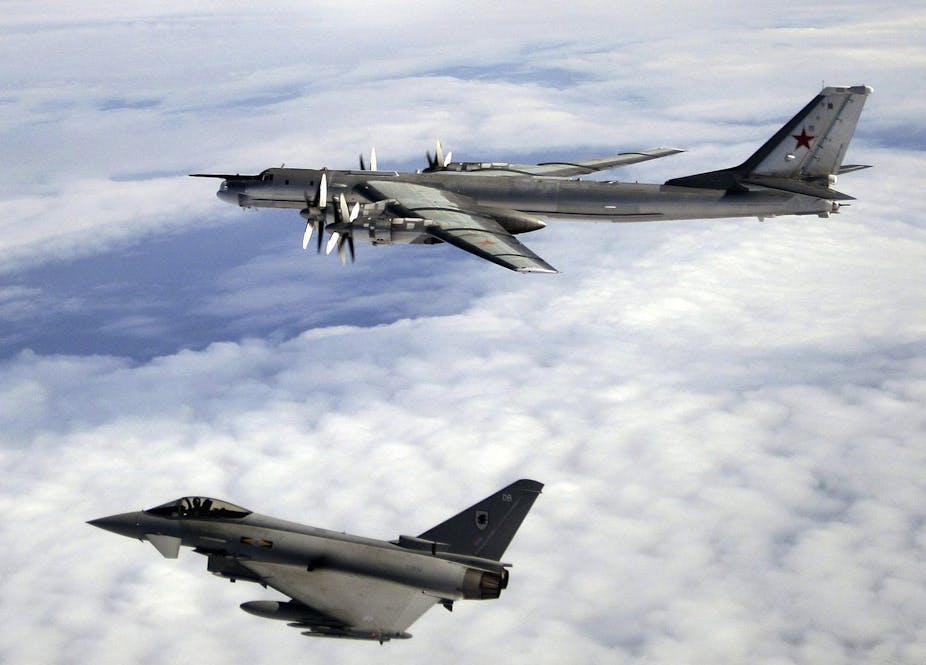There’s an element of sabre-rattling to Russia’s Tu-95 “Bear” aircraft probing the boundary of European nations’ airspace, something that had long gone on during the Cold War and which has restarted under Vladimir Putin. But while their probing of air defences and the subsequent response is well-rehearsed, aircraft flying stealthy around some of the world’s busiest airspace holds the potential for disaster.
The large, propeller-driven Tupolev Tu-95 aircraft were introduced in the 1950s as long-range strategic nuclear bombers, but most of the remaining Bears are reconfigured for either maritime reconnaissance or for gathering electronic intelligence (Elint) – almost certainly what the Bears intercepted by RAF Typhoons off Cornwall were doing.
The flights’ aim is to inspect as much of the electromagnetic emission spectrum around UK airspace as possible. This includes emissions from air defence surveillance radars, fighter aircraft radars and command and control communications. The information gathered is used to update Russian electronic warfare systems. In times of war or conflict this information would be used to program electronic jamming systems on-board Russian aircraft in an attempt to interrupt UK air defence radar and communications. The same techniques are used in relation to warships and for land operations.
This electronic eavesdropping activity is not confined to the borders of UK airspace – within the last year, fighter aircraft have intercepted Tu-95s around Turkey, Portugal, Germany, Denmark, Finland and Sweden and, in late 2014, a major Russian reconnaissance exercise was conducted off the US west coast. The Russian Air Force reconnaissance programme is particularly active during NATO exercises as the electromagnetic spectrum is rich with military information.
Invisible to civilian aircraft
To ensure safety in designated air corridors, commercial and civilian aircraft employ what is called secondary surveillance radar (SSR) to identify themselves to air traffic control (ATC). This is a transponder that periodically transmits location, bearing, altitude and other information to ATC. Military aircraft employ similar but more secure systems known as Identification Friend or Foe (IFF). In peacetime or when military aircraft fly in designated air corridors, IFF is operated in a civilian-compatible mode for safety in order to remain “visible” to air traffic controllers.
Russia’s Bears, on the other hand, turn off their IFF transponders so as to maintain the element of surprise. This prompts British air defences, using active radar to sweep the skies, to detect and respond to them as an unknown potential threat. It also means they are invisible to civilian air traffic control and invisible to other aircraft in the sky – unless close enough to be seen by pilots and crew themselves.
While the aircraft design may be more than 50 years old, the Bears are fitted with sophisticated reconnaissance and navigation systems that enable them to adhere to air safety standards by avoiding controlled airspace and busy air corridors. Nevertheless there have been reports of near misses and violations of sovereign airspace, but it’s difficult to separate fact from fiction.

Near misses
For example, in December 2014 there was a close encounter between a passenger flight taking off from Copenhagen carrying 132 passengers bound for Rome and a Russian reconnaissance aircraft, with transponders turned off, 50 miles south-east of Malmo. A collision was apparently avoided thanks only to good visibility and the alertness of the airliner’s pilots.
Another came in April 2014 when a Russian reconnaissance aircraft entered Dutch airspace before being intercepted by Dutch fighter aircraft. Again, the objective was Elint collection on NATO air defence systems.
Although there have been reported near misses the actual risk to commercial air traffic is considered minimal – but vigilance is necessary. NATO air defence systems are well integrated into civilian air traffic control systems so once an intruding Bear has been identified controllers can be alerted to the presence and aircraft in the vicinity can be warned.
Not just the Russians
However this is not an activity reserved for the Russians. NATO, and particularly the UK and US, also undertake extensive reconnaissance Elint operations against Russia and other countries deemed hostile.
Throughout the Cold War, extensive operations were undertaken against the Soviet Union in areas stretching from the Scandinavian Kola Peninsula, through the Baltic and Germany to the Black Sea, with similar operations in the Far East. This continues today, with incidents in which NATO surveillance aircraft tracked by Russian defences. The Israeli Air Force proved that Elint and electronic warfare was vital during the Lebanon War in 1982 against Russian-built air defence systems supplied to Syria.
But it has not been without casualties – early in the Cold War several NATO reconnaissance Elint aircraft were shot down by the Soviets around the Baltic and Black seas, so these missions were sometimes considered dangerous. Today the Royal Air Force and the USAF employ Boeing RC-135 Rivet Joint reconnaissance aircraft to fulfil the same role for NATO as the Tu-95 Bear, and operate in a similar manner. Perhaps such surveillance, although concerning to some, actually benefits both sides: by keeping the military on their toes and discovering more about each other’s military capabilities, it makes the prospect of war less likely.

